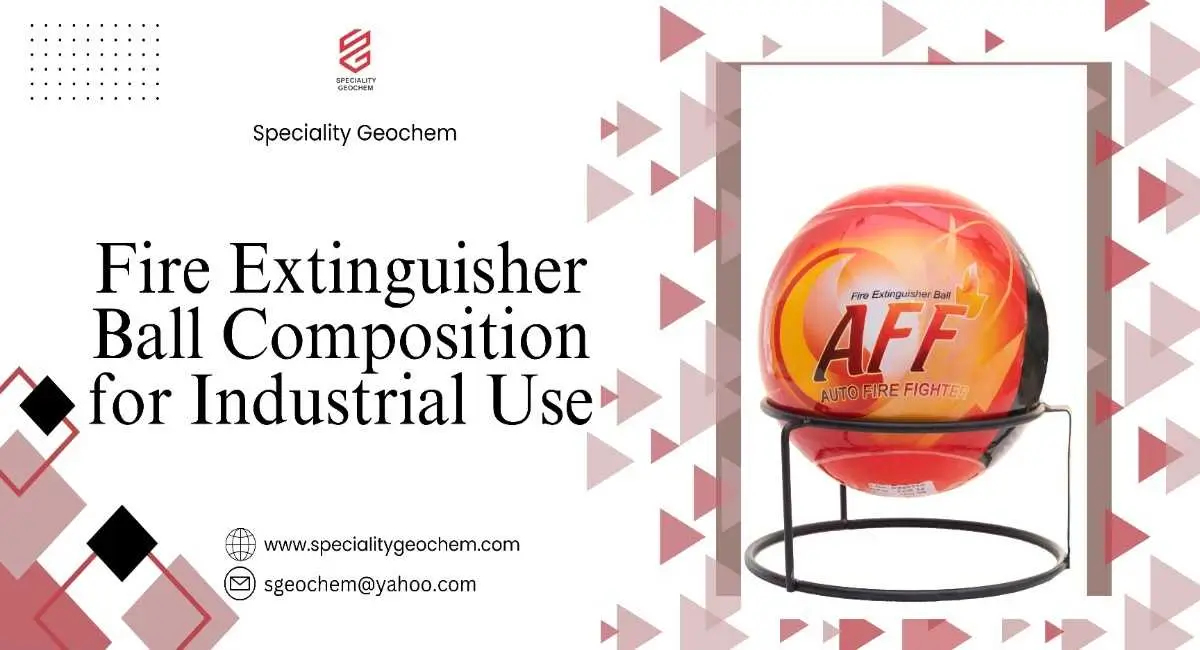Fire Extinguisher Ball Composition: Compliance standards for industrial safety policies are a bare minimum for your industry. Now, the industry is focused on preserving life, assets, and operations in the most effective manner. Technology, over the years, has managed to come up with new tools to improve fire protection. One of the devices to receive serious consideration is the fire extinguisher ball. Unlike the bulky cylinders requiring extensive training and quick decision-making during emergencies, this device turns on automatically when exposed to flames.
The fire extinguisher ball’s true strength lies in its composition (a combination of materials for the outer shell, ignition systems, and chemical agents that work synergistically to contain a fire). Even more, recent innovations are making these devices more reliable, eco-friendly, and suitable for heavy-duty industrial work.
Understanding the Fundamentals of Fire Extinguisher Ball Composition
The fire extinguisher balls are, in essence, a lightweight sphere weighing between 1.3 and 1.5 kilograms. Its composition includes a number of critical layers:
Outer shell: Protecting the inner components, the shell is designed from tough yet light polymers and composite materials, making the ball fire compliant and easy to handle for the user.
Extinguishing Agent: Traditionally, MAP is a dry chemical extinguisher that stops the fire triangle by cutting off oxygen as MAP does.
Safety Layers: Due to the demanding environments, safekeeping coatings and binders ensure the ball does not get damaged and remains safe to store and handle.
Sectors have been able to capitalize on the benefits garnered from fire resting technologies, but the evolution of fire imminent danger has called for the redesign of these fire devices.
Advances in Extinguishing Agents
From Standard Powders to Hybrid Formulas
Fireballs used to rely solely on MAP powder. While effective, it had limitations in handling all fire types. Modern versions now blend MAP with other powders such as Purple K and Sodium Bicarbonate. Strenghting the fire knockdown deficiency, particularly from the liquid and gas fires in factories and refineries.
Eco-Friendly Alternatives
One of the older issues with powders was the residue they left behind and the corrosive effect it had. Loosely describing today’s compositions, such powders are now classified as low residue and non corrosive. Gentler to the machinery, these powders are also safe for the workers of the equipment and do not bear the risk of ozone damaging substances.
Reduced Smoke and Toxicity
Industrial spaces often get choked with thick smoke and toxic fumes, forcing a shutdown of operations. New compositions are now focused learners, aimed to ensure that smoke and toxicity is kept to a minimum. Hence, industrial workers can return to the site promptly post incident without risks.
Redesigning the External Layer
Enhanced Polymers
Dust, heat, and moisture can all affect industrial settings. One manufacturer offers added protection to the inner agent using high-strength ultraviolent (UV) resistant polymers which provide outdoor shield even in harsh conditions.
Biodegradable Materials
The need to be sustainable is no longer something that can be put off to the future. There are some engineers trying to create biodegradable outer shells which industries can use to reduce waste management issues.
More Intelligent Triggering Systems
Reduced Time to Respond
With an average response time of 5–10 seconds, the traditional fire ball is quite slow. For use in scenarios involving highly flammable substances, newer fuses that respond in 2–3 seconds are a welcome change.
Multi-Stage Ignition
Reliability is a key factor when it comes to advanced fire balls. To provide a back-up in the event of a single environmental failure, many advanced options now feature dual triggering layers.
Modification for Industrial Use
Elevated Chemical Concentrations
To enable wider coverage of floor areas, newer industrial balls are equipped with a higher concentration of chemical loads. The effective suppression zone increases to 10 square meters from the 4–5 that was previously standard.
Targeted Class D Chemical Mixtures
Researchers have been developing fire ball options for metals like magnesium and titanium. These metals are prone to unique fires, and so specially tailored class D powders are essential for industrial fire balls.
Anti-Moisture Protection
In moisture-prone coastal areas, powders have a tendency to clump. Modern formulations incorporate anti-moisture additives to ensure that the extinguishing material remains free-flowing and dependable.
Safety and Compliance Enhancements
Non-Toxic Labels: The recent certification processes make certain that the chemicals contained within the ball do not pose a hazard to employees or result in product contamination.
Extended Shelf Life: The addition of stabilizers and anti-caking agents has increased the lifespan of powders from 3 years to nearly 5 years, thus minimizing maintenance costs.
Nanotechnology and the Future of Composition
Undoubtedly, the adoption of nanotechnology is one of the most promising developments. The employment of particulate matter extinguishing agents at the nanoscale not only enhances the efficacy of dispersion but also improves deep penetration into the fire zones, thereby using less powder to achieve a greater effect. As a result, fire extinguisher balls can be made more lightweight and efficient, thus improving safety in industrial environments.
Benefits of Improved Composition in Industry
Cost Savings: Fewer units required due to longer shelf life and wider coverage.
Health Protection: Non-toxic and eco-friendly powders ensures the safety of workers.
Minimal Disruption: Less residue and faster activation reduces downtime following incidents.
Versatility: Multiple fire classes can now be contained by one device due to hybrid compositions.
Sustainability: Eco-policies of many corporations are now supported with biodegradable shells and “green” powders.
Future Outlook
Anticipating the future, the industry will be shaped by the following three trends:
Green Compositions: Focus will be placed on recyclable and biodegradable materials.
Smart Fire Balls: Integration of IoT technologies could notify safety personnel immediately upon the deployment of fire balls.
Global Standards: As the adoption continues to increase internationally, safety performance benchmarks will be standardized to ensure uniform compliance.
Fire Extinguisher Ball Composition: Conclusion
At Speciality Geochem, we recognize that safety innovations need to be dependable. The design of fire extinguisher balls has shifted to incorporating hybrid powders, stronger shells, and eco-friendly materials. These innovations to the designs of fire extinguisher balls are life-saving and business continuity measures, not just technological advancements.
Speciality Geochem equips warehouses, manufacturing plants, and chemical facilities with fire safety solutions by engineering fire extinguisher balls for rapid response, eco-friendly design, and operational flexibility. The advanced fire extinguisher ball designs we offer provide industrial facilities a proactive investment in business continuity, operational resilience, and a lesser safety risk.

